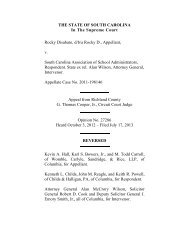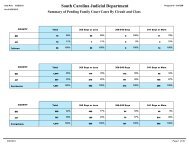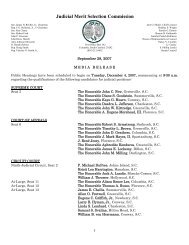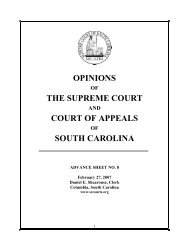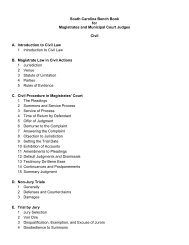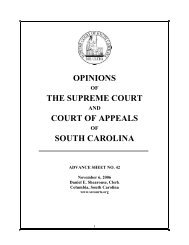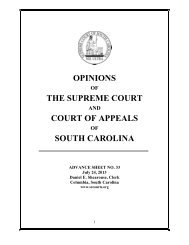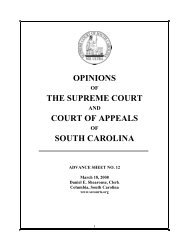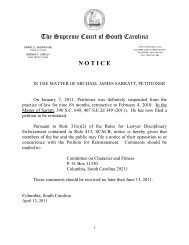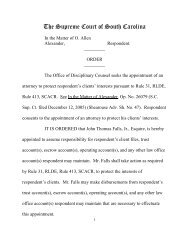Brief of Respondent - SC Judicial Department
Brief of Respondent - SC Judicial Department
Brief of Respondent - SC Judicial Department
You also want an ePaper? Increase the reach of your titles
YUMPU automatically turns print PDFs into web optimized ePapers that Google loves.
TABLE OF CONTENTS TABLE OF AUTHORITIES……………………………………………………………..iiSTATEMENT OF ISSUES ON APPEAL……………………………………………….1STATEMENT OF THE CASE…………………………………………………………..2STATEMENT OF FACTS……………………………………………………………….5ARGUMENTSI. BECAUSE PETITIONER DID NOT RAISE HIS DUE PROCESS CLAIM TOTHE TRIAL JUDGE, IT IS NOT PRESERVED FOR APPELLATEREVIEW………………………………………………………………………….8II. THE COURT OF APPEALS CORRECTLY AFFIRMED THE TRIALCOURT’S RULING THAT THE PETITIONER WAS IN CRIMINALCONTEMPT OF COURT WHEN HE DI<strong>SC</strong>LOSED STATE GRAND JURYINFORMATION SUBJECT TO A PROTECTIVE ORDER…………………...11CONCLUSION…………………………………………………………………………..182
S.C. Nat’l Bank v. Central Carolina Livestock Market,289 S.C. 309, 345 S.E.2d 485 (1986)……………………………………………...8Small v. Pioneer Machinery, Inc.,329 S.C. 448, 494 S.E.2d 835 (1997)………………………………………………16Spartanburg County Dept. <strong>of</strong> Social Services v. Padgett,296 S.C. 79, 370 S.E.2d 872 (1988)………………………………………………..12State v. Bevilacqua,316 S.C. 122, 447 S.E.2d 213 (Ct. App. 1994)…………………………………….12State v. Bowers,270 S.C. 124, 241 S.E.2d 409 (1978)……………………………………………...12, 15State v. Dunbar,356 S.C. 138, 587 S.E.2d 691 (2003)………………………………………………8, 11State v. Passmore,363 S.C. 568, 611 S.E.2d 273 (Ct. App. 2005)………………………………….....8State v. Rector,158 S.C. 212, 155 S.E. 385 (1930)…………………………………………………13Tall Tower, Inc. v. S.C. Procurement Review Panel,294 S.C. 225, 363 S.E.2d 683 (1987)………………………………………………8, 9Townsend v. Townsend,356 S.C. 70, 587 S.E.2d 118 (Ct. App. 2003)……………………………………...12, 15Wagner v. Ezell,249 S.C. 421, 154 S.E.2d 731 (1967)……………………………………………....9Welchel v. Boyter,260 S.C. 418, 196 S.E.2d 496 (1973)………………………………………………12StatutesS.C. Code Ann. § 14-7-1700 (1976)……………………………………………….14S.C. Code Ann. § 14-7-1720 (1976)……………………………………………….14Rule 5.3, RPC, Rule 407, <strong>SC</strong>ACR…………………………………………………174
STATEMENT OF ISSUES ON APPEAL 1. Petitioner’s due process claim is not preserved for appellate review because it wasnever raised to and ruled upon by the trial judge.2. The Court <strong>of</strong> Appeals correctly affirmed the trial court’s ruling that Petitioner wasin criminal contempt <strong>of</strong> court when he disclosed State Grand Jury informationsubject to a protective order.5
STATEMENT OF THE CASEOn February 21, 2002, Bobby Joe Lewis (Lewis) was indicted by the State GrandJury on a charge <strong>of</strong> Conspiracy to Distribute Methamphetamine arising out <strong>of</strong> activitiesoccurring in Laurens and Greenwood Counties, South Carolina (R. pp. 33-34). Asuperseding indictment was filed on June 13, 2002, for the same charge. (R. pp. 35-36).The Court signed a protective order on March 4, 2002, and it was filed on March 5, 2002.(R. pp. 11-12). Sowell, as Lewis’ attorney, filed a Brady motion requesting discoveryfrom the prosecution. (R. p. 27). Along with that information, Sowell received theprotective order <strong>of</strong> non-disclosure. (R. pp. 11-12). Further, it was explained to theattorneys, including Sowell, what was required by the protective order at a hearing heldon March 8, 2002.Subsequently, the State came into custody <strong>of</strong> tapes made by the DrugEnforcement Agency (DEA), in which there was conversation between Jim Molidore(Molidore), a Federal confidential informant, and Kenneth Curtis (Curtis), in whichCurtis discusses information regarding the State Grand Jury’s ongoing criminalinvestigation. Moreover, Curtis indicates on these tapes that his information concerningthe investigation came from Sowell (tapes filed separately with the Court). Based uponthis information, the State filed a Motion for Rule to Show Cause as to CriminalContempt, which was dated and filed on September 20, 2002. (R. pp. 13-15). Thepurpose <strong>of</strong> this action was to determine whether Sowell was to be held in criminalcontempt <strong>of</strong> court for willfully releasing grand jury information to a third party, Gene6
Gore (Gore), without permission <strong>of</strong> the Court or without explaining the obligation <strong>of</strong>secrecy to Gore as required by the Protective Order. 1The non-jury contempt hearing was held before Judge Saunders on November 12,2002. At this hearing the State was allowed to present evidence <strong>of</strong> why based upon thefacts <strong>of</strong> this case that Sowell should be held in contempt based upon his actions. TheState’s position was that Sowell was given the State Grand Jury information pursuant to aprotective order signed by Judge Saunders instructing the attorneys that received theinformation that it was being given pursuant to this protective order and the protectiveorder bound Sowell to the secrecy provisions <strong>of</strong> South Carolina Code Section 14-7-1720.The State contended that if Sowell wanted to release the material to a used car salesmanthat he was going to use as a private investigator, Sowell needed to either explain thesecrecy provisions <strong>of</strong> the Protective Order to Gore or that he needed to obtain anProtective Order to release this information. Sowell was given the opportunity to crossexaminethe State’s witnesses, present evidence, testify on his own behalf and argue hisposition to the Judge. At the conclusion <strong>of</strong> this hearing Judge Saunders verbally held theSowell in contempt. Judge Saunders issued his Order dated November 19, 2002, andfiled November 21, 2002, adjudging Sowell in contempt and sentencing him to serve ajail term <strong>of</strong> ninety days, suspended upon payment <strong>of</strong> a fine in the amount <strong>of</strong> $5,000. (R.pp. 4-6).1 Petitioner claims that he could have produced a copy <strong>of</strong> a letter to Judge Saunders to prove that no<strong>of</strong>fense occurred. However, Petitioner requested that this Court consider additional information and thatrequest was denied and therefore whether this letter actually was ever sent or in the possession <strong>of</strong> Petitionerat the time <strong>of</strong> the hearing before Judge Saunders is not properly before this Court. Additionally, Petitionerhad the opportunity to present such evidence at the contempt hearing, if it did exist and if such a letter wasactually sent to the Honorable Wyatt Saunders he would have had knowledge <strong>of</strong> this letter at the time <strong>of</strong> thehearing and would have taken that information into consideration when making his determining whether tohold the Petitioner in contempt.7
Sowell filed a Motion to Reconsider dated November 20, 2002. (R. pp. 16-17).The Attorney General filed a Response to the Motion to Reconsider dated January 15,2003. (R. pp. 20-23). Judge Saunders issued an Amended Order dated April 4, 2003,leaving all terms <strong>of</strong> the original order but reducing the fine to $2,500. (R. pp. 7-10).On May 9, 2003, Sowell timely served Notice <strong>of</strong> Appeal, and on May 12, 2003,he timely filed such Notice <strong>of</strong> Appeal with the Clerk <strong>of</strong> the lower court. Oral argumentswere held on November 10, 2004, and the Court <strong>of</strong> Appeals affirmed the trial judge’sdecision in an unpublished opinion. State v. Sowell, Op. No. 2005-UP-122 (S.C. Ct. App.filed Feb. 17, 2005). Petition for Rehearing was filed on March 2, 2005, and was deniedby Order dated April 21, 2005.Petitioner then filed a Writ <strong>of</strong> Certiorari to ask the Supreme Court to review hisappeal. The Supreme Court granted the petition for a Writ <strong>of</strong> Certiorari by Order datedSeptember 21, 2005.8
STATEMENT OF FACTSKen Sowell, attorney and Appellant, was retained and paid to represent Lewis byfunds delivered to Sowell by Lewis’ wife. (R. p. 84, lines 1-2). Sowell was firstcontacted by Curtis, a client <strong>of</strong> Sowell, pertaining to an unrelated traffic charge. Sowelltold Curtis that the first thing Lewis would do, if Lewis went to another attorney, wouldbe to name Curtis as his source for illegal narcotics. (R. p. 57, lines 9-14). Sowellfurther told Curtis that he would not let Lewis “flip” on Curtis, and that he needed$25,000 to represent Lewis. (R. p. 57, lines 16-23). Curtis paid the $25,000 for Lewis’representation. (R. p. 57, lines 19-20).Subsequently, Sowell decided to hire a private investigator. (R. p. 80, lines 13-16). Gore was hired as an investigator and was paid $5,000 by someone named Kevin,who was with Curtis. (R. p. 42, lines 2-7).During this same time, the DEA was conducting their own investigation using aconfidential informant by the name <strong>of</strong> Jim Molidore (Molidore). Unbeknownst to Curtis,Molidore was tape recording their conversations. The tapes are difficult to understand,however, it is clear from the tapes that Curtis is telling Molidore about the ongoing GrandJury investigation. Curtis also told Molidore that he had obtained this information fromGore, who had obtained it from Sowell. The tapes also include a discussion in whichCurtis admits that he paid Sowell to represent Lewis in order to be kept apprized <strong>of</strong> theongoing State Grand Jury investigation, which he admits that he was by Gore, whoobtained the information from Sowell. (R. p. 59, lines 16-18) (tapes filed separately withthe Court).9
Gore also testified that during the course <strong>of</strong> the investigation he told Curtis thatthey “know you as K.C.”. (R. p. 53, lines 11-23). Gore also testified that while he wasobtaining this information from Sowell he would show Curtis statements that thatreferred to Curtis as “K.C.”. (R. p. 54, lines 13-24).Gore met with Curtis showed him the statement and told him that an individual bythe name <strong>of</strong> Floyd Eugene Ballew, a/k/a “Dooney” (Dooney) had given law enforcementCurtis’ name, and that Dooney had revealed that Curtis was the drug supplier. He alsoinformed him that “his name was all over the place” and “it looks like you’re in a lot <strong>of</strong>trouble”. He stated that after he read the statement Curtis did not comment, butimmediately left Gore’s <strong>of</strong>fice and did not return. (R. p. 54, line 13 – p. 55, line 17).Gore admitted that he relayed all this information to Curtis throughout the investigationand told Curtis when law enforcement discovered his true name, and further identified theperson who gave the statement as Floyd Eugene Ballew, aka Dooney (Dooney). (R. p.46, lines 2-14).Curtis subsequently was arrested by the DEA and entered a plea before testifyingin Lewis’ second trial. (R. p. 56, lines 19-20).It is well established that Sowell, who was paid by Curtis, released grand juryinformation without a court order or an explanation <strong>of</strong> the Protective Order to Gore, whowas also paid by Curtis. Furthermore, it was established that Curtis, the target <strong>of</strong> theongoing investigation, was kept informed <strong>of</strong> the evidence against him. This is supportedby both Curtis and Gore’s testimony. (R. p. 54, line 13 – p. 55, line 4; R. p. 63, lines 3-5). In Judge Saunders’ Order finding Sowell in criminal contempt he held, “The Statepresented evidence that Curtis was the main target <strong>of</strong> this drug investigation and was the10
source <strong>of</strong> the illegal narcotics. Curtis testified that he was kept apprized throughout theinvestigation <strong>of</strong> the material that pertained to him and paid Gore five thousand dollars toact as a private investigator for the Defendant.” (R. p. 37).The Court held Sowell to be in criminal contempt <strong>of</strong> court for disobedience <strong>of</strong> theCourt’s Protective Order dated the 4 th <strong>of</strong> March, 2002, and the provisions <strong>of</strong> 14-7-1720cited therein. (R. p. 86, line 25 – p. 87, line 4). Specifically, the Judge cites the portion<strong>of</strong> 14-7-1720 that states “any person may not disclose evidence except when permitted bya court for any purpose.” (R. p. 87, lines 5-7). Judge Saunders added that the Court was“concerned about the violation and may not overlook it.” (R. p. 87, lines 10-11). TheJudge issued an Order filed November 21, 2002, in which he found that “the State <strong>of</strong>South Carolina established a record that was clear and specific as to the conduct uponwhich the contempt is based.” (R. p. 5). Further, the Judge found beyond a reasonabledoubt that Sowell was in criminal contempt <strong>of</strong> the Protective Order dated March 4, 2002,and that the release <strong>of</strong> discovery to Gore was a willful act. (R. p. 6).11
Bass v. Bass, 272 S.C. 177, 180, 249 S.E.2d 905, 906 (1978); Henry v. Henry, 296 S.C.285, 372 S.E.2d 104 (Ct. App. 1988). “A demonstration <strong>of</strong> substantial prejudice isrequired to establish a due process claim.” Tall Tower, 394 S.C. at 233, 363 S.E.2d at687.In Tall Tower, there was no substantial prejudice where appellants were givennotice <strong>of</strong> the issues to be determined, afforded an opportunity to be heard by presentingfavorable witnesses, and were given the right to cross-examine adverse witnesses beforea tribunal.In this case, the Petitioner was given notice <strong>of</strong> the allegations against him whenthe State filed a Notice <strong>of</strong> Motion for Rule to Show Cause as to Criminal Contempt andhad a hearing on the matter. See Ballington v. Paxton, 327 S.C. 372, 499 S.E.2d 882 (Ct.App. 1997) (Due process was not violated when Appellants were put on notice throughsection 15-37-10 and Rule 54(d) <strong>SC</strong>RCP that costs will be assessed against them if theydo not prevail.); see also Wagner v. Ezell, 249 S.C. 421, 433, 154 S.E.2d 731, 737 (1967)(Court held that the particulars set forth in the rule to show cause adequately placedWagner on notice as to the issues.).In addition, the hearing held on November 12, 2002, afforded Petitioner ampleopportunity to defend his interests, present favorable witnesses, cross-examine adversewitnesses, and otherwise have a meaningful opportunity to be heard. This is unlike thesituation in Beeks, where mother was denied due process because she was not affordedopportunity to examine, cross-examine, defend her interests, or to be meaningfully heard.South Carolina Dept. <strong>of</strong> Social Services v. Beeks, 325 S.C. 243, 247, 481 S.E.2d 70313
(1997). Thus, even though not preserved for appellate review, Petitioner’s due processwas not denied.Similar to the <strong>Respondent</strong> in Mitchell, Sowell “has simply failed to avail himself<strong>of</strong> ample opportunity to appear and be heard.” Matter <strong>of</strong> Mitchell, 283 S.C. 65, 67, 319 S.E.2d 705, 706 (1984). 14
II.THE COURT OF APPEALS CORRECTLY AFFIRMED THE TRIALCOURT’S RULING THAT THE PETITIONER WAS IN CRIMINAL CONTEMPT OF COURT WHEN HE DI<strong>SC</strong>LOSED STATE GRAND JURY INFORMATION SUBJECT TO A PROTECTIVE ORDER.Petitioner asserts that the Court <strong>of</strong> Appeals erred in affirming the trial court’sruling that he was in criminal contempt <strong>of</strong> court when he disclosed State Grand Juryinformation subject to a protective order. (The State recognizes that Petitioner raised anumber <strong>of</strong> issues but all the issues relate to whether the court properly concluded that hewas in criminal contempt <strong>of</strong> court). The Court <strong>of</strong> Appeals properly affirmed the trialjudge’s ruling that Sowell was in criminal contempt <strong>of</strong> court.As recognized by the Court <strong>of</strong> Appeals, Sowell did not challenge the validity <strong>of</strong>the protective order or the application <strong>of</strong> section 14-7-1720 to him. State v. Sowell, Op.No. 2005-UP-122 (S.C. Ct. App. filed Feb. 17, 2005). Therefore, this issue is notpreserved for review. See Dunbar, 356 S.C. at 142, 587 S.E.2d at 693 (2003). Instead,Sowell’s numerous issues raised center on whether the circuit court judge erred in findinghim in criminal contempt.“A finding <strong>of</strong> contempt rests within the sound discretion <strong>of</strong> the trial judge.”Henderson v. Henderson, 298 S.C. 190, 197, 379 S.E.2d 125, 129 (1989). “[T]his Courtshould reverse a decision regarding contempt only if it is without evidentiary support orthe trial judge has abused his discretion.” Durlach v. Durlach, 359 S.C. 64, 70, 596S.E.2d 908, 912 (2004). “An abuse <strong>of</strong> discretion occurs either when the court iscontrolled by some error <strong>of</strong> law or where the order, based upon findings <strong>of</strong> fact, lacks15
evidentiary support.” Townsend v. Townsend, 356 S.C. 70, 73, 587 S.E.2d 118, 119 (Ct.App. 2003).“The power to punish for contempt is inherent in all courts. Its existence isessential to the preservation <strong>of</strong> order in judicial proceedings, and to the enforcement <strong>of</strong>the judgments, orders and writs <strong>of</strong> the courts, and consequently to the due administration<strong>of</strong> justice.” Curlee v. Howle, 277 S.C. 377, 382, 287 S.E.2d 915, 917 (1982). “Willfuldisobedience <strong>of</strong> an Order <strong>of</strong> the Court may result in contempt.” Spartanburg CountyDept. <strong>of</strong> Social Services v. Padgett, 296 S.C. 79, 82, 370 S.E.2d 872, 874 (1988).An act is willful if “done voluntarily and intentionally with the specific intent todo something the law forbids, or with the specific intent to fail to do something the lawrequires to be done; that is to say, with bad purpose either to disobey or disregard thelaw.” Id. at 82-3, 370 S.E.2d at 874. “Intent for purposes <strong>of</strong> criminal contempt issubjective, not objective, and must necessarily be ascertained from all the facts, wordsand circumstances surrounding the occurrence.” State v. Bevilacqua, 316 S.C. 122, 129,447 S.E.2d 213, 217 (Ct. App. 1994).“In a criminal contempt proceeding, the State has the burden <strong>of</strong> proving the guilt<strong>of</strong> the defendant beyond a reasonable doubt.” State v. Bowers, 270 S.C. 124,131, 241S.E.2d 409, 412 (1978). “One may not be convicted <strong>of</strong> contempt for violating a courtorder which fails to tell him in definite terms what he must do.” Welchel v. Boyter, 260S.C. 418, 421, 196 S.E.2d 496, 498 (1973).The secrecy <strong>of</strong> Grand Jury material cannot be overemphasized. “As long as thegrand jury has been known to our judicial system, and that body came with theorganization <strong>of</strong> our first courts, their acts and proceedings have been regarded as almost16
sacredly secret.” State v. Rector, 158 S.C. 212, 225, 155 S.E. 385, 390 (1930). “Thestringent secrecy provisions contained in the Act [S.C. Code Ann. § 14-7-1720] mirrorthe view long held uniformly by courts nationwide that secrecy <strong>of</strong> grand jury proceedingsis desirable and necessary.” Evans v. State, 363 S.C. 495, 505, 611 S.E.2d 510, 515(2005). As this Supreme Court has acknowledged, “We consistently have recognizedthat the proper functioning <strong>of</strong> our grand jury system depends upon the secrecy <strong>of</strong> grandjury proceedings.” Id.Some <strong>of</strong> the several interests promoted by the secrecy requirement <strong>of</strong> grand jurymaterial are to protect witnesses who have provided testimony, to prevent witnesstampering, and to prevent the escape <strong>of</strong> subjects who may be indicted. Douglas Oil v.Petrol Stops Northwest, 441 U.S. 211 (1979). In order to ensure these objectives wereachieved in this case, the trial court issued a protective order to prevent the disclosure <strong>of</strong>grand jury information obtained through the discovery process from being disseminated.However, due to the petitioner’s unauthorized disclosure, all three <strong>of</strong> the aforementionedobjectives were compromised.Special Agent Richard Gregory testified that Curtis was the target <strong>of</strong> an ongoingGrand Jury investigation. (R. p. 38, lines 2-6). As a result <strong>of</strong> Sowell’s unauthorizeddisclosure to Gore, Curtis was informed by Gore <strong>of</strong> a cooperating witness who gaveinformation about him to law enforcement. (R. p. 46, lines 2-17). In addition, Curtistestified that as a result <strong>of</strong> being kept apprized <strong>of</strong> the Grand Jury investigation, he movedhis “meth lab” in order to avoid being caught. (R. p. 63, lines 6-24).Notwithstanding the secrecy <strong>of</strong> grand jury information, “[a] defendant is entitledto review and reproduce recorded materials <strong>of</strong> those proceedings, subject to the17
limitations contained in Sections 14-7-1720, 14-7-1770, and Rule 5, S.C.Crim.P.” Evansat 506, 611 S.E.2d at 516 (2005), citing S.C. Code Ann. § 14-7-1700 (Supp. 2003).Section 14-7-1720 prohibits the Attorney General or his designee from disclosing stategrand jury information except when directed by the court for one <strong>of</strong> five limitedpurposes. One <strong>of</strong> these purposes is “providing the defendant the materials to which he isentitled pursuant to Section 14-7-1700.” S.C. Code Ann. § 14-7-1720(A)(4). Moreover,subsection (A) <strong>of</strong> 14-7-1720 mandates, “If the court orders disclosure <strong>of</strong> mattersoccurring before a state grand jury, the disclosure must be made in that manner, at thattime, and under those conditions as the court directs.”In this case, disclosure <strong>of</strong> grand jury information was made by the AttorneyGeneral to the Petitioner pursuant to Section 14-7-1720(A)(4), subject to the mandatoryconditions imposed by the judge through the protective order. The order stated:IT IS HEREBY ORDERED that the Attorney General is protected if he choosesto disclose to the attorney for the defendants in the above-captioned casestestimony taken in the State Grand Jury and interviews <strong>of</strong> witnesses and otherdocuments in which must subsequently be disclosed under normal circumstancesat trial. It is understood that the State Grand Jury material is being provided onlyfor purposes <strong>of</strong> the trial <strong>of</strong> the above-captioned cases. The attorney for thedefendants and the defendants are bound by the secrecy provisions <strong>of</strong> § 14-7-1720. (Emphasis added).IT IS FURTHER ORDERED that, pursuant to S.C. Code Ann. §§ 14-7-1700 and–1720(A) (Law. Co-op. 1976), the defendants and their attorneys are prohibitedfrom photocopying any State Grand Jury testimony, interviews <strong>of</strong> witnesses andany other documents that may be disclosed to the defendants and their attorneysin the above-captioned cases. All such materials shall be completely destroyed atthe conclusion <strong>of</strong> the case. Nothing in this order prohibits the defendants or theirattorneys from using Brady material for purposes <strong>of</strong> preparing for trial.By means <strong>of</strong> the protective order, the judge applied the secrecy provisions <strong>of</strong> section 14-7-1720 to Sowell, pursuant to the court’s power to condition the disclosure <strong>of</strong> informationunder subsection (A). As such, the judge imposed on Sowell the secrecy provisions that18
are applicable to the Attorney General under section 14-7-1720. Sowell then willfullyviolated the protective order when he disclosed the information to Gore without beingdirected by the court or explaining the secrecy requirement to Gore. In the contemptorder, the judge found that “it was clearly established that the Defendant was not directedby the Court to release this information to Gore, nor did he explain the secrecyrequirement <strong>of</strong> the Protective Order.” (R. p. 6).The trial judge did not abuse his discretion in finding Sowell in criminalcontempt. The judge’s finding was supported by ample evidence in the record and wasnot based on an error <strong>of</strong> law, and therefore should not be reversed. See Durlach, 359 S.C.at 70, 596 S.E.2d at 912 (2004); see also Townsend, 356 S.C. at 73, 587 S.E.2d at 119(Ct. App. 2003). In determining Sowell willfully violated the protective order, the judgefound the State presented clear and specific evidence <strong>of</strong> Sowell’s conduct and that Sowellwas guilty beyond a reasonable doubt. Sowell, Op. No. 2005-UP-122 (S.C. Ct. App. filedFeb. 17, 2005). Thus, the Court <strong>of</strong> Appeals correctly held that “the judge’s decision wasnot based on an error <strong>of</strong> law given he relied on the appropriate legal standards for afinding <strong>of</strong> contempt.” Id.In addition, the Court <strong>of</strong> Appeals correctly held that there is sufficient evidence tosupport the judge’s ruling. The trial judge sat as the trier <strong>of</strong> facts. As stated in Bowers, ina criminal contempt proceeding in which the trial judge sits as trier <strong>of</strong> the facts, “[w]herethere is sufficient evidence worthy <strong>of</strong> belief, this Court will not disturb those findings.”270 S.C. at 131, 241 S.E.2d at 412.In this case, there is ample evidence in the record to support the judge’s ruling.The trial court held, and the Court <strong>of</strong> Appeals affirmed that, “There is no dispute that19
Sowell failed to inform the court that he disclosed the grand jury material to Gore untilprompted by the State’s motion for a rule to show cause,” and that “Sowell failed toexplain to Gore the obligation <strong>of</strong> secrecy.” Sowell, Op. No. 2005-UP-122 (S.C. Ct. App.filed Feb. 17, 2005). In support <strong>of</strong> this ruling, the trial judge found Gore and Curtis to bemore credible witnesses than Sowell. Id. In fact, the most convincing evidence thatSowell could pr<strong>of</strong>fer was his own testimony. The fact finder is given broad discretion indetermining the credibility or believability <strong>of</strong> a witness. See Small v. Pioneer Machinery,Inc., 329 S.C. 448, 494 S.E.2d 835 (1997). On appeal, this Court is not required to ignorethe fact that the trial judge, who saw and heard the witnesses, was in a better position toevaluate their credibility and assign comparative weight to their testimony. See Cherry v.Thomasson, 276 S.C. 524, 525, 280 S.E.2d 541, 541 (1981)Additional supporting evidence can be found throughout the record. Goretestified that when Sowell left the grand jury information with him, he was not given anyinstructions. (R. p. 43, line 24 – p. 44, line 3). Further, the judge stated “Gore admitsthat the information contained in this material was related to Mr. Kenny Curtis,specifically he testified that when the Defendant was named by a cooperating witness hetold Curtis about this statement.” Sowell, Op. No. 2005-UP-122 (S.C. Ct. App. filed Feb.17, 2005); (R. p. 46, lines 2-14; R. p. 54, line 13 – p. 55, line 4). In addition to Gore’stestimony, Curtis testified that he was kept apprized <strong>of</strong> the Grand Jury investigation byGore. (R. p. 63, lines 3-5). On the DEA tapes that were played for the Court and madepart <strong>of</strong> the record, Curtis discusses Grand Jury information that he received from Gore,who received the information from Sowell. Curtis further testified that as a result <strong>of</strong> theinformation he received through Gore, he moved his methamphetamine lab because <strong>of</strong>20
fear <strong>of</strong> getting caught. (R. p. 63, lines 6-22). Based on the evidence in the record, theCourt <strong>of</strong> Appeals correctly affirmed the trial judge’s ruling and held that the judge did notabuse his discretion in holding Sowell in criminal contempt.Every attorney is charged with the duty <strong>of</strong> confidentiality and responsibility togive appropriate instruction and supervision to non-lawyer assistants concerning theobligation not to disclose confidential information. See Rule 407, <strong>SC</strong>ACR, Rule 5.3,RPC, comment 1. Surely an attorney should even give greater precautionary warningsconcerning the disclosure <strong>of</strong> highly secretive State Grand Jury material to a nonemployeeprivate investigator. Sowell, however, failed to give any such instructions orseek approval from the court, even after being specifically required to by the protectiveorder. As stated by the Court <strong>of</strong> Appeals, “By requiring defense counsel to proceedthrough the proper channels, similar to the State, the court will be able to preserve thesanctity <strong>of</strong> grand jury material.” Sowell, Op. No. 2005-UP-122 (S.C. Ct. App. filed Feb.17, 2005).21
CONCLUSION For all <strong>of</strong> the foregoing reasons, it is respectfully submitted that the judgment andconviction <strong>of</strong> the lower court be affirmed.Respectfully submitted,HENRY McMASTERAttorney GeneralJOHN W. McINTOSHChief Deputy Attorney GeneralJENNIFER D. EVAN<strong>SC</strong>hief, State Grand JuryPost Office Box 11549Columbia, <strong>SC</strong> 29211(803) 734-3693BY:ATTORNEYS FOR RESPONDENTColumbia, <strong>SC</strong> January 17, 2006 22
STATE OF SOUTH CAROLINAIN THE SUPREME COURT__________Appeal From Greenwood CountyHonorable Wyatt T. Saunders, Jr., Judge__________THE STATE,<strong>Respondent</strong>,vs.KENNETH E. SOWELL,Petitioner.__________PROOF OF SERVICE__________I, Jennifer D. Evans, Counsel for the <strong>Respondent</strong>, certify that I have served thewithin <strong>Brief</strong> <strong>of</strong> <strong>Respondent</strong> on Petitioner by depositing three (3) copies <strong>of</strong> the same in theUnited States mail, postage prepaid, addressed to him as follows: Kenneth E. Sowell,Esquire, 212 North Avenue, Anderson, <strong>SC</strong> 29625.I further certify that all parties required by Rule to be served have been served.This 17 th day <strong>of</strong> January, 2006.____________________________JENNIFER D. EVANSOffice <strong>of</strong> Attorney GeneralState Grand JuryPost Office Box 11549Columbia, <strong>SC</strong> 29211(803) 734-3693ATTORNEY FOR RESPONDENT23



